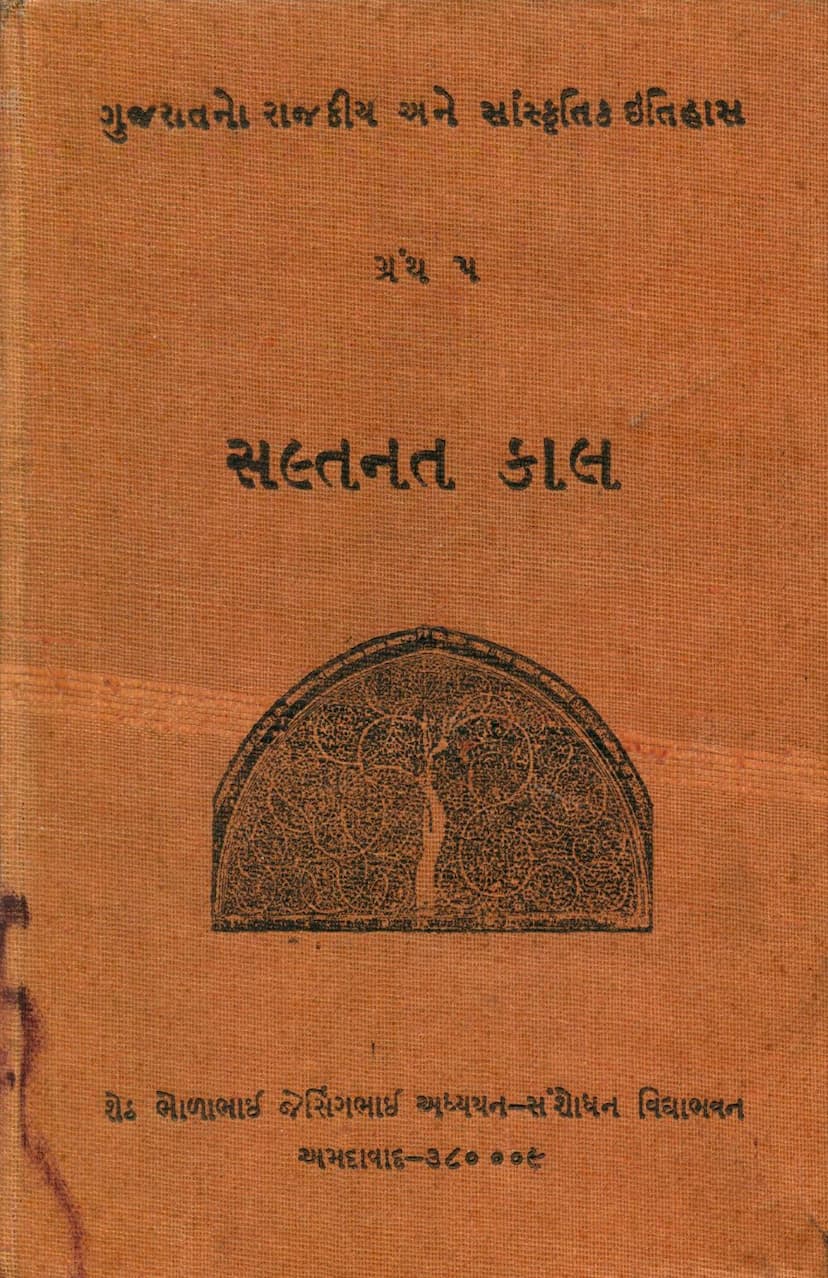Gujaratno Rajkiya Ane Sanskritik Itihas Part 05 Saltanat Kal
Added to library: September 1, 2025

Summary
Based on the provided Gujarati text, here is a comprehensive summary in English of "Gujaratno Rajkiya ane Sanskritik Itihas Part 05 Saltanat Kal" by Rasiklal C Parikh and Hariprasad G Shastri:
Book Title: Gujaratno Rajkiya ane Sanskritik Itihas Part 05 Saltanat Kal (Political and Cultural History of Gujarat Part 05: The Sultanate Period)
Author(s): Rasiklal C Parikh, Hariprasad G Shastri
Publisher: B J Adhyayan Sanshodhan Vidyabhavan, Ahmedabad
Summary:
This fifth volume of the "Political and Cultural History of Gujarat" series focuses on the Sultanate period in Gujarat, spanning approximately 269 years from the decline of the Solanki-Vaghela dynasty and the rise of the Delhi Sultanate in Gujarat around 1300 CE, until the Mughal conquest in 1572-73 CE. The book comprehensively covers the political and cultural landscape of Gujarat during this significant era.
Key Aspects Covered:
-
Introduction and Sources: The initial chapter (Chapter 1) details the various source materials crucial for reconstructing the history of this period. These include Persian-Arabic historical chronicles (Tawaarikh), Arabic-Persian inscriptions, and coins, which are of particular importance. However, the text emphasizes that the history of Gujarat during the Sultanate period is not solely dependent on these sources but also relies heavily on Sanskrit, Prakrit, and Old Gujarati literature, as well as Sanskrit-Gujarati inscriptions. Writings from the early 16th century by European travelers (Firangi) also contribute valuable information.
-
Political History:
- Delhi Sultanate Rule (Chapter 2): This section covers the period when Gujarat was under the direct rule of the Delhi Sultanate, detailing the administrations of Alauddin Khalji and the Tughluqs. It highlights the events from the initial conquest by Alauddin Khalji (1299-1304 CE) until the establishment of the Gujarat Sultanate around 1403-07 CE.
- Gujarat Sultanate (Chapters 3, 5, 6): This major part of the book chronicles the history of the independent Gujarat Sultanate, covering its establishment and stability. It details the reigns of various sultans, starting from Zafar Khan (Muzaffar Shah I), Sultan Muhammad Shah I, and Sultan Ahmed Shah I. It delves into the significant rulers and events, including the shift of the capital to Ahmedabad.
- Ahmedabad as the Capital (Chapter 4): The volume dedicates a chapter to the founding and development of Ahmedabad, which became the prominent capital of Gujarat after Anhilwad Patan. It describes the city's administration, economic conditions, and cultural contributions during the Sultanate period.
- Gujarat's Sultanate Under various Rulers (Chapter 6): This chapter continues the narrative of the Gujarat Sultanate, covering the reigns from Muzaffar Shah II to Muzaffar Shah III, detailing the political events and transitions.
- Portuguese Entry: An appendix to Chapter 6 discusses the arrival and increasing influence of the Portuguese in Gujarat, their eventual establishment of power in Diu and Daman.
- Contemporary States (Chapter 7): To provide a complete political history of Gujarat, this chapter examines the contemporary states and kingdoms that interacted with Gujarat. This includes the Jadeja dynasty in Kutch, the Chudasma and Jethwa dynasties in Saurashtra, the Vaja dynasty in Southern Saurashtra, the Chauhan Chauhan of Champaner, the Rathods of Idar, and the Parmars of Malwa, Mewad, and Khandesh, as well as the Delhi Sultanate itself.
-
Administrative System (Chapter 8): This section provides an overview of the state administration during the Sultanate period, differentiating between the administration under the Delhi Sultanate and the independent Gujarat Sultanate. It also includes an appendix on the Sultanate's mints and the coins issued by various sultans, offering a valuable numismatic perspective.
-
Cultural History (Chapters 9-13): This substantial portion of the book shifts focus to the cultural developments during the Sultanate era:
- Social Conditions (Chapter 9): Examines the social structure, including the Hindu and Muslim communities, their customs, food, attire, religious practices, education, and entertainment.
- Economic Conditions (Chapter 10): Details the economic status of Gujarat during this period, including industries, major exports and imports, the role of Khambhat as a port, and the decline of its maritime significance.
- Language and Literature (Chapter 11): Explores the evolution and significant contributions to the languages and literature of the era, including Sanskrit, Prakrit, Old Gujarati, and Persian works. It highlights key literary figures and their works.
- Script (Chapter 12): Discusses the scripts used during the period, primarily Nagari and Arabic scripts, and their evolution.
- Religion and Sects (Chapter 13): Analyzes the religious landscape, covering Hinduism (Shaivism, Vaishnavism, Shaktism), Jainism, Islam, and Zoroastrianism, and their influence on society. An appendix provides details on the spread of Islam and its impact in Gujarat.
-
Archaeology (Chapters 14-17): This section is dedicated to the material culture and artistic achievements of the period:
- Archaeological Findings (Chapter 14): Details information gathered from archaeological excavations and site investigations, including pottery, stones, metals, paper, and wood artifacts.
- Architectural Monuments (Chapter 15): Provides an extensive description of architectural monuments, categorizing them into Nagara (civic) architecture (city planning, forts, reservoirs) and Islamic architecture (mosques, tombs, idgahs). It highlights notable buildings and construction techniques, with specific mention of Champaner and Islamic architecture.
- Sculptures (Chapter 16): Discusses the sculptural art of the period, covering general characteristics, divine images (Hindu and Jain), and Islamic figurative art.
- Paintings (Chapter 17): Examines the painting traditions, including miniatures and murals from this era.
-
Appendices: The book concludes with essential appendices, including genealogies, a bibliography, a glossary of terms, maps, and photographs, which further enrich the historical and cultural understanding of the period.
Overall Significance:
This volume serves as a crucial resource for understanding a transformative period in Gujarat's history. It meticulously reconstructs the political events, administrative structures, and the vibrant cultural and artistic developments that shaped Gujarat under the rule of various Sultanates. The detailed analysis of diverse source materials, including literary works, inscriptions, coins, and archaeological findings, makes this book a definitive study of the Sultanate era in Gujarat. The volume underscores the resilience of Gujarat's culture and traditions amidst external influences and political shifts.